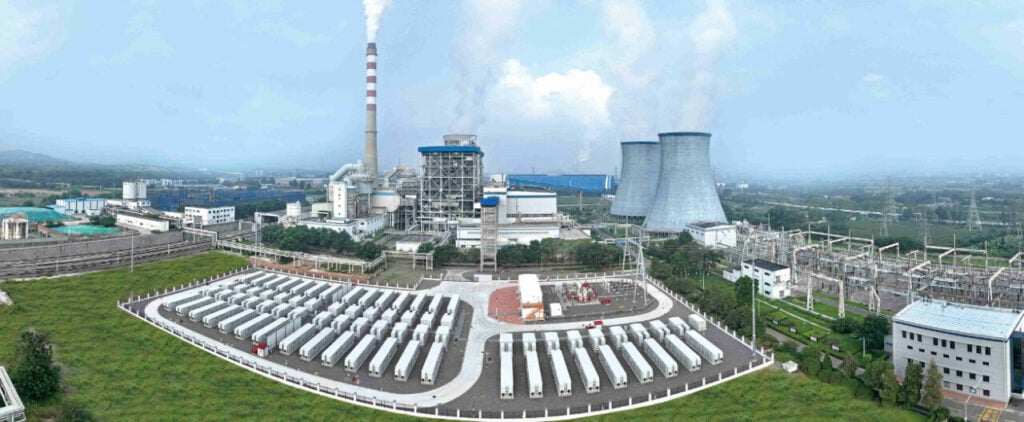
A large-scale battery storage project in China, which is set to remain the world’s biggest market by country this decade according to BNEF. Image: Hyperstrong.
According to the International Energy Agency (IEA) and BloombergNEF, battery storage was the most invested-in energy technology in 2023 with the biggest-ever annual growth in deployments recorded.
The organisations have each just published a new report apiece, the IEA focusing on battery storage and BloombergNEF on the wider energy storage market.
In both the IEA ‘Special report on batteries and secure energy transitions,’ and the BloombergNEF H1 2024 edition of its ‘Global energy storage outlook’ report, a key takeaway is that there was more investment in battery storage worldwide than ever before during 2023.
The IEA said 42GW of batteries were deployed across utility-scale, behind-the-meter, off-grid and solar home stationary energy storage installations in the year, and said that battery storage was the most invested in of all commercially available energy sector technologies in 2023.
Meanwhile, BloombergNEF counted annual energy storage deployments in 2023—excluding pumped hydro energy storage (PHES) and therefore largely comprising battery storage installations—at 44GW/96GWh.
BloombergNEF (BNEF) said that was roughly three times the amount tallied for 2022. It is forecasting a 60% jump this year to around 67GW/155GWh of global deployments in 2024, and a compound annual growth rate (CAGR) of the market to the end of the decade of 21%.
That means 2030 annual deployments of 137GW/445GWh and a cumulative installed capacity reaching 782GW/2,205GWh by the end of that year. Energy storage will grow much faster than solar PV or wind, for which the analysis and research group have predicted 8.9% and 6.6% CAGRs, respectively, from 2024 to 2030.
APAC, China to lead deployments to 2030
The falling costs of grid-scale battery energy storage system (BESS) technology, a topic that has been much discussed recently on Energy-Storage news, will support growth, BNEF said. It found that as of February 2024, a 2-hour duration turnkey BESS in China cost an average of US$115/kWh, a 43% decrease from a year before.
With lithium iron phosphate (LFP) now firmly the lithium-ion (Li-ion) battery sub-chemistry of choice for the stationary BESS market, BNEF expects the share of nickel manganese cobalt (NMC) BESS systems to continue declining, representing only 1% of the global market by the end of the decade.
The Asia-Pacific region is set to lead deployments, driven by China and representing about half of all new additions. EMEA’s share will rise from about 11% this year to about 19% by 2030, while the Americas will be the slowest-growing market, seeing its share fall from about 28% on a gigawatt-hour basis in 2024 to 19% in 2030.
That said, by country, the US will be second only to China as the world’s largest market. China added 22GW/47GWh in 2023 and will get to 335GW/938GWh cumulative installations by 2030; the US added 7.4GW/22GWh in 2023 and will reach 134GW/484GWh cumulative deployments by 2030, according to BNEF’s forecasts.
Germany is going to be the third biggest market through this decade. The European country deployed 3.8GW/6.1GWh in 2023 and is forecasted for 62GW/109GWh cumulative installed base by 2030.
Electricity, transport: ‘Two pillars for decarbonisation’
IEA’s special report is focused on the broader theme of batteries’ importance to the global energy transition. The agency’s executive director, Fatih Birol, outlines in a foreword his belief that batteries’ impact will be most profound in the power and transport sectors.
Indeed, despite the ubiquity of batteries in modern life, including consumer electronics, the energy sector, including EVs and battery storage, accounts for 90% of lithium-ion battery demand today, up from around 50% just eight years ago in 2016.
The reduction in cost of Li-ion by about 90% since 2010, higher energy densities and longer battery lifetimes account for the technology’s dominance in both EV and BESS, with the IEA finding Li-ion battery prices have declined from US$1,400/kWh in 2010 to below US$140/kWh in 2023.
“The electricity and transport sectors are two key pillars for bringing down emissions quickly enough to meet the targets agreed at COP28 and keep open the possibility of limiting global warming to 1.5 °C,” Birol said.
“Batteries will provide the foundations in both areas, playing an invaluable role in scaling up renewables and electrifying transport while delivering secure and sustainable energy for businesses and households.”
However, to be on track to meet those climate targets, battery production and use needs to increase even more dramatically, the IEA said, requiring a sixfold increase in global energy storage deployments by the end of this decade. The agency anticipates that new capacity to comprise 90% batteries and the remaining 10% to come from PHES.
Further effort needed
BNEF found that despite the meteoric rise of battery storage, the technology still largely requires supportive policy frameworks, including but not limited to subsidies. It was the case that most, if not all, of the leading energy storage markets are regions with energy storage targets, BNEF said.
Similarly, the IEA said that while battery storage with renewables are cost-competitive with coal generation in India, for example, and will be cheaper than coal in China or gas-fired generation in the US in a matter of years, the costs still need to come down further to scale up deployment. The agency also noted that while investments in manufacturing have ramped up, the supply chains are still dependent on a limited number of countries, presenting risk if diversification of supply is not achieved.
BloombergNEF’s parent group Bloomberg said in January that major scale-up of battery manufacturing and supply chain investments are still short of what they need to be to meet global emissions targets, despite overall increases in investment in energy transition technologies.
Energy-Storage.news’ publisher Solar Media will host the 2nd Energy Storage Summit Asia, 9-10 July 2024 in Singapore. The event will help give clarity on this nascent, yet quickly growing market, bringing together a community of credible independent generators, policymakers, banks, funds, off-takers and technology providers. For more information, go to the website.




 SUBSCRIBE
SUBSCRIBE